
By Eric Valentine

If you could design a School Resource Officer job description checklist that could make parents, staff and students feel safer, it’d go something like this:
• Military training
• Police training
• Experience training police officers in K-12 safety
• Educated in psychology with a master’s degree in Emergency Management; and Ph.D. coursework under way
• Life experience involving mass shooting
• Children who attend a district school
• Spouse who teaches at a district school
Thanks to Hailey Police Officer Morgan Ballis’ life and career, Blaine County School District can check all those boxes come August. That’s when Ballis, who was hired by the City of Hailey in February, will begin the role he was brought onto the force to perform, school resource officer—a school’s first line of defense against a variety of ill will that has been making its way onto campuses all too often the past two decades.
“It was Sandy Hook that really hit home. That’s when I knew I wanted to dedicate my life to this specifically,” Ballis said, recounting the moment he heard about the Dec. 14, 2012, tragedy in Newtown, Connecticut, when a 20-year-old shot and killed 26 people. Twenty of the victims were children between six and seven years old, and six were adult staff members.
That was when Ballis was still in the Marines—something he did for 11 years until leaving in 2015—and around the same time his daughter began kindergarten and his wife began teaching. It was also just a year removed from a traumatic experience his family had while still residing in Tucson, where Ballis was born and raised.
On the morning of Jan. 8, 2011, Ballis’ mother headed to the supermarket to do some grocery shopping. She saw a large crowd of people out front and inquired about the event. It was a constituents gathering called Congress At Your Corner hosted by U.S. Congresswoman Gabrielle Giffords. Ballis’ mom was talking to two men, one of them was then future Congressman Ron Barber and another man who—after a sudden series of gunshots—was covered in blood.
Six people died in the attack and another 13, including Giffords, were wounded. Ballis’ mother escaped injury, but the entire family and their community couldn’t escape the trauma of it all. For Ballis, his military training and his community’s tragedy would begin to shape his fate.
Prevention & Response
Today, Ballis’ community is the Valley, and his family has grown roots here quickly. His wife is a literacy coach at Ernest Hemingway STEAM School, his daughter attends Wood River High School, and his son attends Wood River Middle School, where last month the campus—and the entire district—went into lockdown when the popping of a balloon in a restroom was mistaken for a possible gunshot.
Ballis was in training elsewhere that day, but he said the district’s reaction and law enforcement’s response to the potential emergency was perfect.
“I love that a teacher loves my son so much they didn’t hesitate to call 9-1-1,” Ballis remarked, adding that the teacher did the right thing by not checking with administrators first. “The one thing there’s never enough of in an active-shooter situation is time. Staff and students need options other than waiting for law enforcement to show up.”
And that’s one of two critical areas of focus for Ballis in his new role—to move the district from a lockdown-only response to an options-based response. Something he says Superintendent Jim Foudy has already started to adopt across the district. Already the state has performed a vulnerability assessment on every campus, and a district task force has gone to every site and collected data that will be used to establish policy and procedure at each campus, referred to as Targeted Attack Protocol (TAP).
“We have leaders within this district and the community that are out in front of this issue,” Ballis said.
These protocols will cover everything from how students and staff can disrupt an active-shooting situation and self-evacuate, rather than be penned up in classrooms where they are easy targets for a shooter.
“We’re not teaching martial arts and we’re not doing any drills that will cause additional trauma,” a concept called trauma-informed practices, Ballis said
The other mission-critical component to Ballis’ work, he said, will be helping to establish a prevention element to a tragedy like this. Already a behavioral intervention team is being used across the district to identify students or staff or situations that may develop into a real threat or an extreme tragedy. Behavioral intervention teams are typically made up of administrators, school psychologists, social workers, and law enforcement, among others.
“Everyone communicates and everyone stays in their lane,” Ballis said. “My feeling is that if we’re at the point where there’s a threat, we’ve sort of already failed.”
In last month’s lockdown there was another key takeaway, according to Ballis. Parents need to know their role in a crisis.
“They want to know what’s going on and they want to help,” Ballis explained.
But in real-time, no-drill situations, parents on campus clog roads and driveways and make it harder for trained personnel to do their job.
“That’s on us,” Ballis said. “We have to communicate better.”


